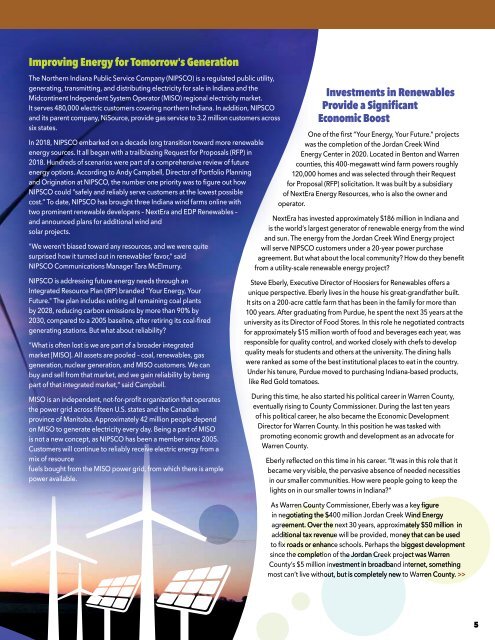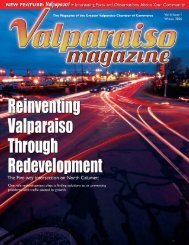2022SummerMagazine_Web
You also want an ePaper? Increase the reach of your titles
YUMPU automatically turns print PDFs into web optimized ePapers that Google loves.
Improving Energy for Tomorrow's Generation<br />
The Northern Indiana Public Service Company (NIPSCO) is a regulated public utility,<br />
generating, transmitting, and distributing electricity for sale in Indiana and the<br />
Midcontinent Independent System Operator (MISO) regional electricity market.<br />
It serves 480,000 electric customers covering northern Indiana. In addition, NIPSCO<br />
and its parent company, NiSource, provide gas service to 3.2 million customers across<br />
six states.<br />
In 2018, NIPSCO embarked on a decade long transition toward more renewable<br />
energy sources. It all began with a trailblazing Request for Proposals (RFP) in<br />
2018. Hundreds of scenarios were part of a comprehensive review of future<br />
energy options. According to Andy Campbell, Director of Portfolio Planning<br />
and Origination at NIPSCO, the number one priority was to figure out how<br />
NIPSCO could "safely and reliably serve customers at the lowest possible<br />
cost.” To date, NIPSCO has brought three Indiana wind farms online with<br />
two prominent renewable developers – NextEra and EDP Renewables –<br />
and announced plans for additional wind and<br />
solar projects.<br />
"We weren't biased toward any resources, and we were quite<br />
surprised how it turned out in renewables’ favor," said<br />
NIPSCO Communications Manager Tara McElmurry.<br />
NIPSCO is addressing future energy needs through an<br />
Integrated Resource Plan (IRP) branded "Your Energy, Your<br />
Future." The plan includes retiring all remaining coal plants<br />
by 2028, reducing carbon emissions by more than 90% by<br />
2030, compared to a 2005 baseline, after retiring its coal-fired<br />
generating stations. But what about reliability?<br />
"What is often lost is we are part of a broader integrated<br />
market [MISO]. All assets are pooled – coal, renewables, gas<br />
generation, nuclear generation, and MISO customers. We can<br />
buy and sell from that market, and we gain reliability by being<br />
part of that integrated market," said Campbell.<br />
MISO is an independent, not-for-profit organization that operates<br />
the power grid across fifteen U.S. states and the Canadian<br />
province of Manitoba. Approximately 42 million people depend<br />
on MISO to generate electricity every day. Being a part of MISO<br />
is not a new concept, as NIPSCO has been a member since 2005.<br />
Customers will continue to reliably receive electric energy from a<br />
mix of resource<br />
fuels bought from the MISO power grid, from which there is ample<br />
power available.<br />
Investments in Renewables<br />
Provide a Significant<br />
Economic Boost<br />
One of the first “Your Energy, Your Future.” projects<br />
was the completion of the Jordan Creek Wind<br />
Energy Center in 2020. Located in Benton and Warren<br />
counties, this 400-megawatt wind farm powers roughly<br />
120,000 homes and was selected through their Request<br />
for Proposal (RFP) solicitation. It was built by a subsidiary<br />
of NextEra Energy Resources, who is also the owner and<br />
operator.<br />
NextEra has invested approximately $186 million in Indiana and<br />
is the world’s largest generator of renewable energy from the wind<br />
and sun. The energy from the Jordan Creek Wind Energy project<br />
will serve NIPSCO customers under a 20-year power purchase<br />
agreement. But what about the local community? How do they benefit<br />
from a utility-scale renewable energy project?<br />
Steve Eberly, Executive Director of Hoosiers for Renewables offers a<br />
unique perspective. Eberly lives in the house his great-grandfather built.<br />
It sits on a 200-acre cattle farm that has been in the family for more than<br />
100 years. After graduating from Purdue, he spent the next 35 years at the<br />
university as its Director of Food Stores. In this role he negotiated contracts<br />
for approximately $15 million worth of food and beverages each year, was<br />
responsible for quality control, and worked closely with chefs to develop<br />
quality meals for students and others at the university. The dining halls<br />
were ranked as some of the best institutional places to eat in the country.<br />
Under his tenure, Purdue moved to purchasing Indiana-based products,<br />
like Red Gold tomatoes.<br />
During this time, he also started his political career in Warren County,<br />
eventually rising to County Commissioner. During the last ten years<br />
of his political career, he also became the Economic Development<br />
Director for Warren County. In this position he was tasked with<br />
promoting economic growth and development as an advocate for<br />
Warren County.<br />
Eberly reflected on this time in his career. “It was in this role that it<br />
became very visible, the pervasive absence of needed necessities<br />
in our smaller communities. How were people going to keep the<br />
lights on in our smaller towns in Indiana?”<br />
As Warren County Commissioner, Eberly was a key figure<br />
in negotiating the $400 million Jordan Creek Wind Energy<br />
agreement. Over the next 30 years, approximately $50 million in<br />
additional tax revenue will be provided, money that can be used<br />
to fix roads or enhance schools. Perhaps the biggest development<br />
since the completion of the Jordan Creek project was Warren<br />
County’s $5 million investment in broadband internet, something<br />
most can’t live without, but is completely new to Warren County. >><br />
ValpoChamber.org 5

















